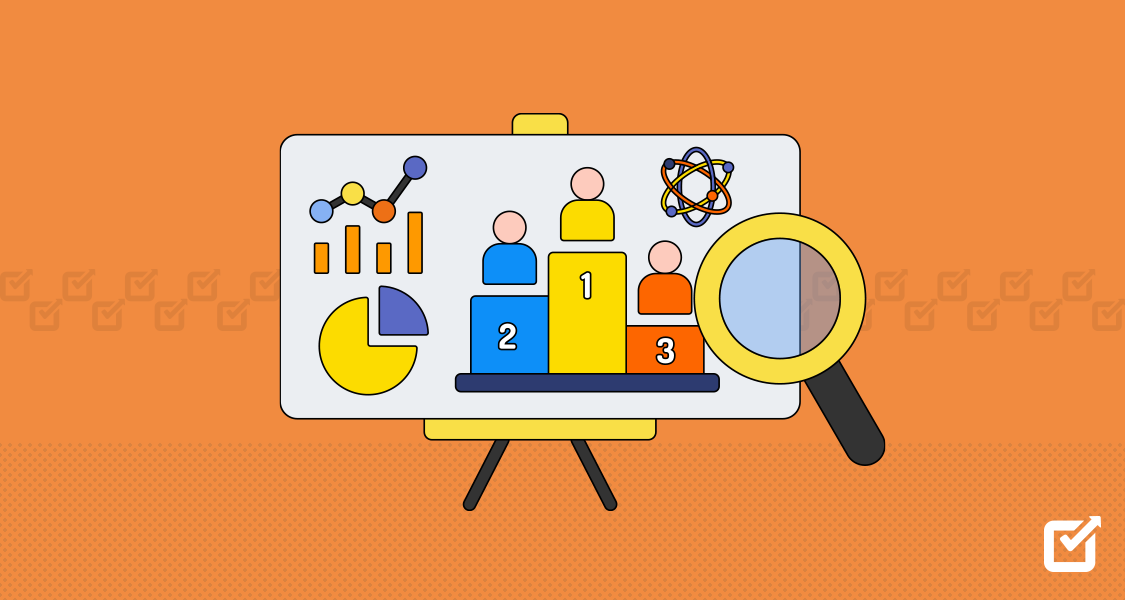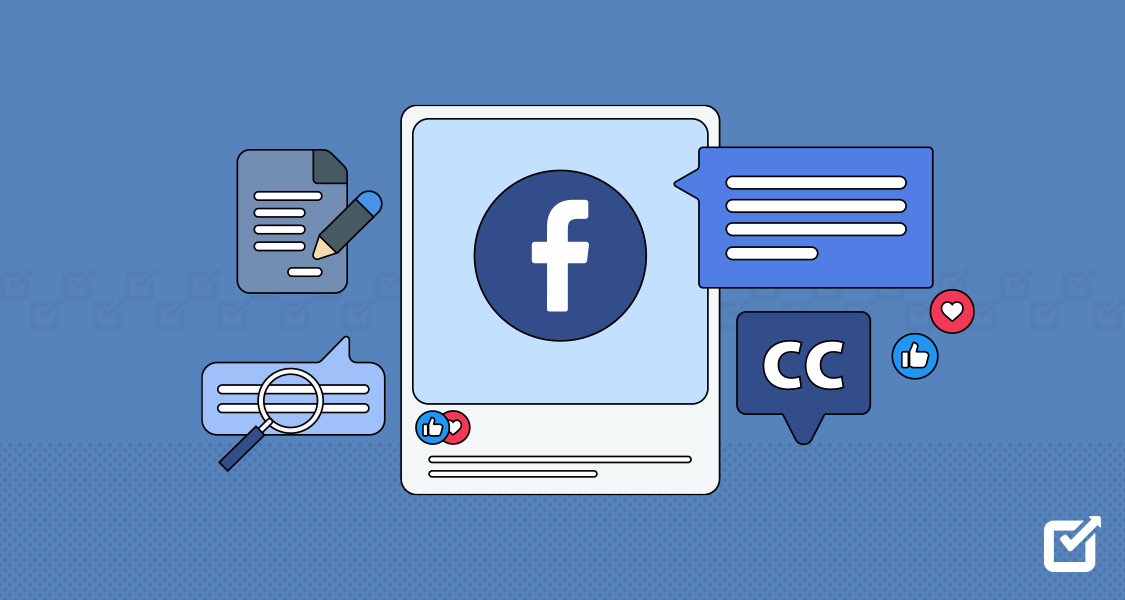Ever feel like your competition is crushing it on the platforms while you’re stuck playing catch-up? Yeah, us too. That’s where competitive analysis comes in, and trust us, it can help you win in social media management.
Think of it this way: you wouldn’t go into a battle blind, right? So why approach your social media strategy without knowing your competitor’s next move? By peeking over their shoulder (don’t worry, it’s totally ethical!), you can discover insights about what’s working (and what’s flopping) in your industry.
That being said, you shouldn’t just copy their strategy. Instead, use their strengths and weaknesses to inform your winning strategy.
So, how do you become a competitive analysis master? Stay tuned because we’re about to break down the methods. Let’s get started!
What Is Competitive Analysis?
Competitive analysis systematically evaluates your competitors to gain insights into their strengths, weaknesses, opportunities, and threats. It is an essential aspect of strategic planning that empowers businesses to make informed decisions, capitalize on market trends, and mitigate potential risks.
Want to Stay Ahead? Try Social Champ!
Stop playing social media catch-up and become the trendsetter with Social Champ’s powerful scheduling tool.
Market Trends Identification
Competitive analysis provides a bird’s-eye view of market trends, helping businesses stay abreast of changes in consumer preferences, emerging technologies, and industry shifts. By understanding the market’s direction, companies can position themselves as innovators and trendsetters, gaining a competitive edge.
Positioning Strategy
Analyzing competitors allows businesses to identify gaps in the market that they can exploit. Whether offering a unique value proposition or addressing unmet needs, competitive analysis aids in strategic positioning, helping you differentiate yourself from the competition.
Customer Insights
Understanding your competitors’ customer base provides insights into their preferences, behaviors, and pain points. By leveraging this information, businesses can tailor their products or services to meet customer needs better, enhancing customer satisfaction and loyalty.

A snapshot of competitive research of Social Champ vs Competitor Risk Mitigation
By analyzing, businesses can anticipate potential threats and challenges. Whether it’s a new entrant, regulatory changes, or technological disruptions, proactive identification of risks enables organizations to develop contingency plans and stay resilient in the face of adversity.
The Competitive Analysis Process
Competitors Identification
Start by identifying direct and indirect competitors. Direct competitors offer similar products or services, while indirect competitors may address the exact customer needs through different means.
Information Collection
Collect data on your competitors’ products, pricing strategies, market share, target audience, and marketing tactics. Utilize public sources, industry reports, customer reviews, and social media to gather comprehensive insights.
SWOT Analysis
Conduct each competitor’s SWOT analysis (Strengths, Weaknesses, Opportunities, Threats). This structured assessment provides a holistic view of their internal and external factors, guiding your understanding of their overall business strategy.
Check Competitive Standards
Compare your performance metrics with those of your competitors. This could include key performance indicators (KPIs), such as revenue growth, customer acquisition cost, and market share. Benchmarking helps identify areas for improvement and sets performance targets.
Competitor analysis is not a one-time task but an ongoing process that evolves with the business environment. By investing time and resources into understanding the competitive landscape, businesses can make informed decisions, capitalize on opportunities, and navigate challenges effectively.
Featured Article: How to Make Money on Instagram in 2025 – Social Champ
Why Performing a Competitive Analysis Is Important?
Strategic Decision-Making
Competitive analysis provides valuable insights that enable businesses to make informed strategic decisions. By understanding the competitive landscape, organizations can identify opportunities and threats, guiding their decision-making processes.
The analysis helps businesses stay attuned to market trends, technological advancements, and shifts in consumer behavior. With this knowledge, organizations can align their strategies with the prevailing market dynamics.
Market Positioning
Market positioning is a critical part of competitive analysis. It involves:
- Identifying Unique Value Proposition:
Through competitive analysis, businesses can identify gaps in the market and develop a unique value proposition. This distinctive positioning sets them apart from competitors and helps attract a specific target audience. - Productive Branding:
Understanding how competitors position themselves allows organizations to craft a branding strategy that resonates with their target market. This helps build a strong brand image and enhances customer loyalty.
- Identifying Unique Value Proposition:
Product Development
By analyzing competitors’ products and services, businesses can identify unmet needs in the market. This insight is a foundation for developing innovative solutions catering to customer demands.
Monitoring competitors’ innovations and technological advancements ensure that a company stays competitive. It inspires improving existing products or creating new ones to meet evolving consumer expectations.
Pricing
Pricing is critical for customer analysis. It helps you create rates that your target market can afford and is drawn to.
- Competitive Pricing
Understanding competitors’ pricing strategies is crucial for setting competitive yet profitable prices. It helps businesses balance offering value to customers and maintaining healthy profit margins.
- Value Perception
Analyzing how competitors position their pricing relative to the perceived value of their products aids in determining optimal pricing structures. This insight ensures that pricing aligns with the value perceived by customers.
Customer Insight
Competitive analysis provides insights into competitors’ customer bases, allowing businesses to understand customer preferences, behaviors, and expectations. This knowledge is invaluable for tailoring products and services to meet customer needs effectively.
Learning from competitors’ successes and failures in customer acquisition and retention strategies helps organizations refine their approaches. This contributes to building a loyal customer base and sustaining long-term profitability.
It is required for strategic decision-making, effective market positioning, innovation, efficient pricing strategies, customer insights, and proactive risk management. It gives firms the intelligence to overcome market complexity and emerge as industry leaders.
How to Do Competitive Analysis
The Basics of Competitive Analysis: A Step-By-Step Guide
Keeping a close eye on your competitors is crucial to stay ahead of the curve. Competitive analysis is the key to gaining valuable insights that can shape your strategic decisions and help your business thrive in a dynamic market. Let’s delve into the simple steps of conducting a practical competitive analysis.
Identify Your Competitors
- Direct Competitors: Start by identifying businesses that offer similar products or services. These are your direct competitors and are often the most prominent contenders in the market.
- Indirect Competitors: Look beyond the obvious. Identify indirect competitors that may not offer the same products but cater to similar customer needs. Understanding these players provides a holistic view of your competitive landscape.
- Substitute Products or Services: Consider substitutes that customers might choose instead of your offerings. These could be alternative solutions that fulfill the same need, even if in a different way.
Gather Information
- Online Research: Begin your analysis by learning how to conduct a competitive analysis through online competitor research. Explore competitors’ websites, social media profiles, and online reviews. This helps in understanding their messaging, target audience, and overall online presence.
- Industry Reports:
Leverage industry reports and market research to gather quantitative data on market trends, growth rates, and key players. These reports offer a broader perspective on the competitive landscape.
A snapshot of competitive research of Social Champ vs Competitor - Customer Feedback:
Dive into customer reviews and feedback. Understanding what customers appreciate or dislike about your competitor’s products or services provides valuable insights into their strengths and weaknesses.
Conduct a SWOT Analysis
- Strengths: Identify your competitors’ strengths, such as strong brand recognition, innovative products, or a robust distribution network. Understanding these strengths helps you gauge their competitive advantage.
- Weaknesses: Analyze the weaknesses of your competitors, such as operational inefficiencies, customer service issues, or outdated technology. Recognizing these areas allows you to identify potential opportunities for your business.
- Opportunities: Explore opportunities that your competitors might need to take advantage of. This could include entering new markets, partnering with key players, or leveraging emerging trends they have yet to capitalize on.
- Threats: Recognize external threats that could impact your competitors, such as changes in regulations, economic downturns, or technological disruptions. Anticipating these threats prepares your business to navigate similar challenges.
Implement Benchmarking
- Key Performance Indicators (KPIs): Compare your performance metrics with your competitors. Evaluate KPIs like market share, revenue growth, customer acquisition cost, and customer satisfaction. Benchmarking provides a quantitative measure of your standing in the market.
- Identify Performance Gaps: Analyze the gaps between your performance and your competitors. This could reveal areas where your business excels and others where improvement is needed. Addressing these gaps helps refine your strategic priorities.
Analyze Pricing Strategies
- Pricing Models: Understand how your competitors price their products or services. Analyze whether they adopt a value-based pricing model, cost-plus pricing, or penetration pricing. This knowledge informs your pricing strategy.
- Discounts and Promotions: Examine the deals and promotions offered by competitors. Assess how these strategies impact their customer acquisition and retention. This insight helps in crafting competitive pricing and promotional tactics.
Explore Customer Insights
- Target Audience: Identify and understand your competitors’ target audience. Analyze their marketing messages and branding to discern the demographics and psychographics of their customer base.

A snapshot of competitive research, Traffic share by countries - Customer Feedback: Explore customer reviews to grasp the strengths and weaknesses of competitors from the customer’s perspective. Identify recurring themes in feedback to gauge the aspects that matter most to customers.
- Target Audience: Identify and understand your competitors’ target audience. Analyze their marketing messages and branding to discern the demographics and psychographics of their customer base.
Stay Updated
- Continuous Monitoring: Competitive analysis is not a one-time task. Regularly monitor your competitors and the industry landscape for changes. Keep an eye on new entrants, emerging trends, and shifts in customer preferences to adapt your strategies accordingly.
- Adaptation and Iteration: Use the insights from ongoing competitive analysis to adapt your business strategies. Be ready to iterate and refine your approach based on the evolving competitive landscape.
When Should You Do a Competitive Analysis
The timing of competitive analysis is crucial. It’s not merely a one-off task but a dynamic process that needs to align with various stages of your business’s lifecycle and the broader market dynamics. Here’s a breakdown of when to conduct it for optimal impact.
Market Entry or Expansion
Conduct competitive analysis before entering a new market or expanding your product line. This comprehensively explains existing players, market dynamics, and potential opportunities or challenges.
With this knowledge, you can tailor your entry strategy for maximum impact. Analyzing competitors helps identify gaps in the market that your business can fill. Whether offering a unique product feature or addressing an underserved segment, this early analysis informs your market entry strategy and positions your business strategically.
Product Development or Enhancement
- In the Ideation Phase: Start competitive analysis early in the product development lifecycle. Understanding what similar products or services are available in the market helps refine your product concept. It allows you to incorporate unique features or improvements that give your product a competitive edge.
- Throughout Development: Continuously monitor competitors as your product evolves. This ensures that you stay ahead in innovation and are responsive to any changes in the competitive landscape. Real-time insights during development enable you to make agile adjustments based on market trends and consumer preferences.
Strategic Planning and Decision-Making
- Regular Review: Embed competitive analysis as a regular component of your strategic planning process. This could be conducted annually or semi-annually, depending on the industry’s pace. Regular reviews ensure your strategic decisions are well-informed and aligned with the competitive environment.
- Mergers and Acquisitions: Conduct a thorough competitive analysis before engaging in mergers or acquisitions. This helps evaluate the strengths and weaknesses of the target company and assess how its integration aligns with your business goals. In-depth competition analysis mitigates risks and maximizes the synergies between the entities.
Marketing Campaigns and Positioning
Before launching a marketing campaign, analyze the strategies and positioning of competitors. This ensures that your campaign is differentiated and resonates with your target audience. It also helps in identifying potential pitfalls or areas where competitors have succeeded.
You must also monitor competitors during your marketing campaign. If a competitor introduces a disruptive promotion or messaging strategy, being aware allows you to adapt quickly. This agility is particularly crucial in industries where market conditions change rapidly.
Financial Performance Assessment
Timely financial analysis helps identify trends and potential areas for improvement, allowing for proactive adjustments to your business strategy.
Conduct competitive analysis when engaging with investors or stakeholders. This provides a clear picture of your position in the market and helps articulate your competitive advantage. It instills confidence and facilitates more informed investment decisions.
Technology and Industry Trends
Stay abreast of technological advancements and industry trends through ongoing competitive analysis. This is particularly vital in industries where technology plays a significant role. Identifying emerging technologies or trends early allows your business to adapt and innovate proactively.
Before embarking on major innovation initiatives, analyze the landscape to understand your competitors’ actions. This ensures that your innovation aligns with market demands and helps you avoid redundant or outdated efforts.
Customer Feedback and Satisfaction
Regularly gather and analyze customer feedback to assess satisfaction levels. When a competitor makes significant changes to their products or services, use this opportunity to gauge how it impacts customer sentiment. Proactively addressing customer concerns helps maintain loyalty and gain a competitive advantage.
Post-Crisis Evaluation
In the aftermath of industry crises or major shifts, conduct a competition analysis to evaluate how your competitors have navigated the challenges. Learning from their experiences provides valuable insights for crisis management and ensures resilience in adversity.
Competitive Analysis Examples
Competitive analysis is not just a theoretical exercise; it’s a dynamic process that businesses use to gain actionable insights into their competitive landscape. By examining industry players, understanding market dynamics, and identifying key trends, companies can make informed decisions to stay ahead. Let’s explore a few real-world examples of competitive analysis across various industries.
Technology and Gadgets
Example – Smartphone Market
Competitor Identification: In the smartphone industry, companies like Apple, Samsung, and Huawei continuously conduct competitive analyses to understand each other’s product features, pricing strategies, and market positioning.
SWOT Analysis: Apple, known for its strong brand and ecosystem, analyzes its competitors to identify potential threats, such as emerging Chinese brands. Meanwhile, competitors assess Apple’s weaknesses, such as product pricing, to capitalize on market segments.
Product Development: When Samsung introduced foldable smartphones, competitors analyzed this innovation. Apple, for instance, monitored customer responses and considered incorporating similar features into its future products, showcasing how it informs product development.
E-commerce and Retail
Example – Online Retail Giants
Competitor Landscape
In e-commerce, giants like Amazon and Alibaba continually engage in competitive analysis to stay ahead. Amazon, for instance, closely monitors Alibaba’s expansion strategies in international markets and assesses potential impacts on its global market share.Pricing and Promotions
It plays a pivotal role during major sales events like Black Friday or Singles’ Day. Amazon and Alibaba analyze each other’s pricing strategies, discount structures, and promotional tactics to attract and retain customers during these critical periods.Customer Experience
E-commerce companies use competitive analysis to enhance the customer experience. By examining competitors’ websites, user interfaces, and feedback, companies can identify areas for improvement and implement changes to stay competitive in the online retail landscape.Automotive Industry
Example – Electric Vehicles (EVs)
Market Trends
The rise of electric vehicles (EVs) in the automotive industry has prompted competitive analysis among major players like Tesla, General Motors, and Volkswagen. Companies continuously analyze each other’s EV offerings, technological advancements, and infrastructure developments.
Strategic Alliances
The competitive analysis goes beyond product features. Companies assess their competitors’ strategic alliances and partnerships. For instance, if one company secures a significant partnership for EV charging stations, competitors take note and may seek similar collaborations to maintain competitiveness.
Regulatory Impact
The automotive industry closely monitors global regulations related to emissions and sustainability. Competitors analyze each other’s efforts to comply with environmental standards, understanding that regulatory compliance can be a source of competitive advantage or disadvantage.
Fast-Food Industry
Example – Burger Chains
Menu Innovation
Fast-food chains like McDonald’s, Burger King, and Wendy’s use competitive analysis to drive menu innovation. When a competitor introduces a successful product, others analyze its popularity and may respond with a similar or enhanced offering to capture market share.
Pricing Strategies
Pricing is a crucial aspect of it in the fast-food industry. Companies regularly monitor each other’s pricing, value meals, and promotional discounts. If one chain introduces a value deal, competitors may adjust their pricing strategies to remain competitive.
Market Expansion
Competitive analysis is crucial when a fast-food chain plans to expand into a new market or region. Understanding the local competitors, consumer preferences, and pricing dynamics enables companies to tailor their offerings and marketing strategies for maximum impact.
Healthcare and Pharmaceuticals
Example – Pharmaceutical Companies
Drug Development
Pharmaceutical companies conduct competitive analysis in drug development. If a competitor advances in a specific therapeutic area, others analyze the clinical trial results and adjust their own competitor research and development strategies to stay competitive.
Regulatory Landscape
Regulatory approvals play a significant role in the pharmaceutical industry. Companies closely monitor their competitors’ interactions with regulatory bodies, understanding the potential impact on their own drug approval processes and market access.
Market Access Strategies
In healthcare, understanding competitors’ market access strategies is crucial. It helps pharmaceutical companies assess how their competitors navigate pricing, reimbursement, and market positioning for their products.
Financial Services
Example – Fintech Startups
Innovation and Technology
Fintech startups analyze traditional financial institutions and other fintech players to stay innovative. By understanding competitors’ technological advancements, user experiences, and financial products, they can differentiate themselves in a crowded market.
Regulatory Compliance
In the financial services sector, regulatory compliance is paramount. Fintech companies conduct competitive analysis to understand how their competitors navigate regulatory challenges. This helps them proactively address compliance issues and maintain trust with customers.
Customer Acquisition
Competition analysis in financial services involves studying customer acquisition strategies. If a competitor launches a successful marketing campaign or introduces a new customer loyalty program, others analyze these approaches to refine their own customer acquisition tactics.
Challenges in Competitive Analysis
Competitive analysis is an essential technique for running a business, but it has its own set of obstacles. Let’s discuss some common problems faced during competition analysis.
Data Availability and Reliability
Acquiring detailed competition data is difficult owing to restricted public access to specific facts. However, relying on external sources creates possible challenges in ensuring the reliability and correctness of obtained data. This underlines the importance of thorough validation methods in competitive analysis.
Changing the Business Environment
Managing dynamic markets presents challenges since rivals adjust quickly by changing strategy, offering new items, or rapidly entering and quitting the market. Identifying new firms is difficult, especially when they gain traction quickly. This demands continuous competitive analysis to remain ahead of changing market dynamics and growing competitors.
Looking At Subjective Variables
A third problem in competitive analysis is understanding the data and turning it into practical suggestions. Depending on the breadth and aim of your competition analysis, you may need to consider various factors and situations that impact your company decisions, such as market trends, consumer preferences, regulatory changes, and competitor reactions. You may also need to balance your data analysis’s quantitative and qualitative components, such as statistics and narratives.
Implementation of Data
The last difficulty of competitive analysis is implementing the data analysis and suggestions into your business strategy and operations. If we look at the amount of integration and support from your business, you may have to face opposition or challenges in implementing your competitor analysis conclusions. These may include financial limits, resource limitations, cultural barriers, and change management. You may also need to be careful about the impact and value of your competitive analysis implementation, including ROI, KPIs, and feedback.
Globalization and Multiple Markets
Companies running on a global scale have to face difficulties of international competitiveness. They had to deal with varied regulatory frameworks and cultural differences. Analyzing rivals gets more complex as they adjust their tactics and offers to individual countries, necessitating an advanced knowledge of local market conditions for successful competition analysis in the global business environment.
Time-Sensitive Data
Competitor data can turn into fool’s gold if you can’t access it quickly and accurately. Finding good information needs support, but accessing fresh data promptly? That’s another hurdle.
The culprits:
- Stale insights: Data ages quickly, rendering your intel useless. Frustrating, right?
- Limited real-time: Not all tools offer up-to-date competitor info, leaving you blindsided.
- Fragmented data: Many tools provide isolated pieces, making the big picture a time-consuming puzzle.
- Error-prone under pressure: Incomplete data forces analysts to make quick decisions, leading to miscalculations and bad calls.
The fix: Prioritize tools with fresh and real-time data, ensure clear communication between data acquisition and analysis, and remember that accurate, timely data is your key to implementing actionable competitor insights that propel your marketing strategy.
Social and Legal Factors
Global competition is complex: you need to navigate diverse regulations and cultural nuances while competing across borders. Analyzing rivals involves understanding localized strategies and offerings, which demands deep dives into each market’s unique conditions.
Mastering this complex, competitive landscape empowers organizations to customize strategies, ensuring successful engagement and region-specific approaches that resonate with local audiences.
Featured Article: 35+ Twitter Stats and Analytics That You Can’t Afford to Skip in 2025
In Conclusion
Competitive analysis is an essential skill in the corporate environment, where success is determined by adaptation and foresight. It goes beyond a routine check on rivals; it is a strategic requirement, a compass that guides firms through market complexities.
As businesses navigate challenges and opportunities, integrating competitor analysis into their strategies ensures survival and sustainable success. So, accept the findings, react strategically, and allow competitive analysis to push you toward leadership in today’s changing business world.
Frequently Asked Questions
1. What Is a Competitive Analysis Framework?
2. What Are the Three Important Factors of Competitive Analysis?
- Timing Precision: Avoid rushing product development to be first; learn from competitors’ timing mistakes for long-term success.
- Market Entry Focus: Analyze competitors’ pricing, product fit, and marketing for a strong market entry strategy.
- Distinctive Edge: Emphasize your product’s uniqueness for success in a crowded market.

















